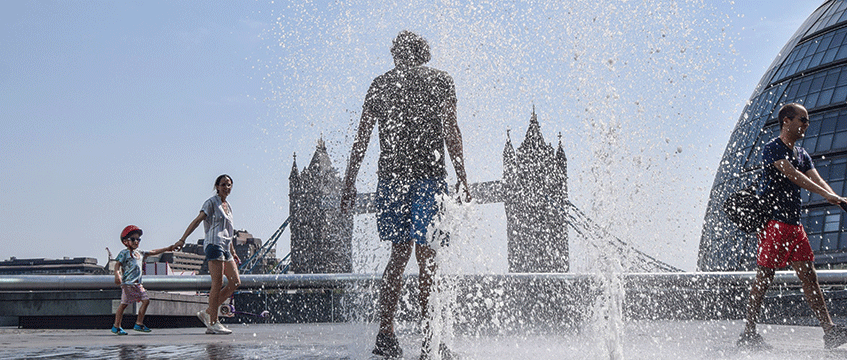Real estate leaders have warned that the built environment is “dangerously ill-equipped” to deal with the effects of the climate crisis, in a week that saw a record-breaking heatwave in the UK.
The temperature in the UK passed 40°C for the first time on 18 July as the country put in place its first ever red extreme heat warning. The Met Office said the likelihood of such extreme weather “could be as much as 10 times more likely in the current climate than under a natural climate”. The London Fire Brigade on Tuesday declared a major incident as several grass and building fires broke out across the capital.
Individuals from across the built environment called for a renewed focus on green infrastructure, rethought urban design and policy commitments to help reshape towns and cities for what many fear will be the new normal.
“The record-breaking temperatures this week were scarily close to the Met Office’s hypothetical predictions for 2050 – the year the UK is aiming to be net zero,” said Chris Bowie-Hill, director of innovation delivery at Hydrock, an engineering design and sustainability consultancy. “The one thing we have all realised, from either travelling into the office or working from home, is that our buildings and infrastructure are dangerously ill-equipped to cope with such extreme weather conditions. We need to evolve the way we design our cities to manage the unprecedented hot weather.”
Bowie-Hill added: “These temperatures are a sad manifestation of human activities and we have taken our natural environment for granted for too long. However, the answer to the problem is also in nature. We should be looking at nature-based solutions, introducing blue and green infrastructure, such as increasing urban regreening and using water to double as flood mitigation. And we shouldn’t be afraid to rethink how we plan our cities, such as introducing passive design measures and learning from our Mediterranean neighbours – places like Barcelona’s Gothic Quarter with narrow, winding streets that create natural shade and cooler walking routes.”
Incorporating climate-friendly design
With question marks over whether the country’s next prime minister will stand by the Conservative Party’s net-zero strategy – itself ruled as unlawful in its current form this week – Ed Baker, Singapore-based practice principal and head of urbanism at architecture firm Broadway Malyan, said policymakers must acknowledge the need to incorporate “climate-friendly design into urban planning”.
“What we have seen with the record-breaking temperatures across the UK has the potential to be the new normal for our cities,” Baker said. “Overcoming rising urban temperatures is becoming as relevant today in London as it is in Asia or the Middle East. Design must focus on components that can mitigate extreme temperatures and positively influence microclimate – interventions like water features, physical shade structures, or ‘breeze corridors’ – ultimately improving quality of life.”
Jake Heitland, urban strategist at Lendlease, said the challenges of the climate crisis are “too big and complex for one individual, organisation or sector to tackle on their own”, adding: “We must act now and in ways we have never done before to find real-world solutions – collaborating with the greatest minds and innovators from business, government, local communities, academia, arts, and science – to ensure our cities remain liveable places for current and future generations.”
At King’s Cross, sustainability manager Rob Miller said the week’s heatwave “brought the climate crisis to the front of our minds once again” and highlighted the need for real estate to “continue to play a proactive role in reducing its contribution to climate change by addressing whole life carbon emissions”.
“Extreme weather of all types also highlights the increasing need for urban environments to adapt to the impacts of climate change and create spaces that are comfortable for residents and visitors,” Miller added.
“The implementation of an integrated green infrastructure strategy will play a pivotal role in this process, and we must continue to prioritise approaches such as passive design to ensure our buildings can withstand the high temperatures that will become more common.”
To send feedback, e-mail tim.burke@eg.co.uk or tweet @_tim_burke or @EGPropertyNews











